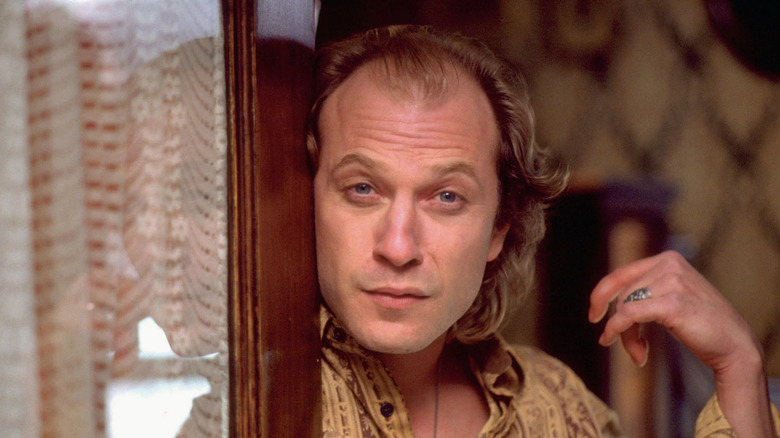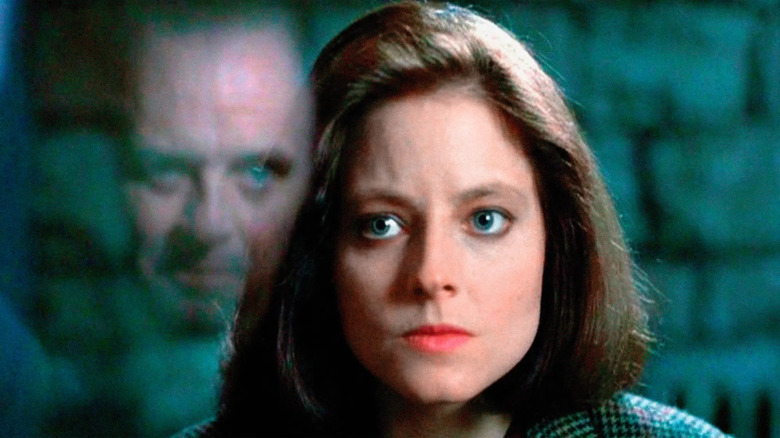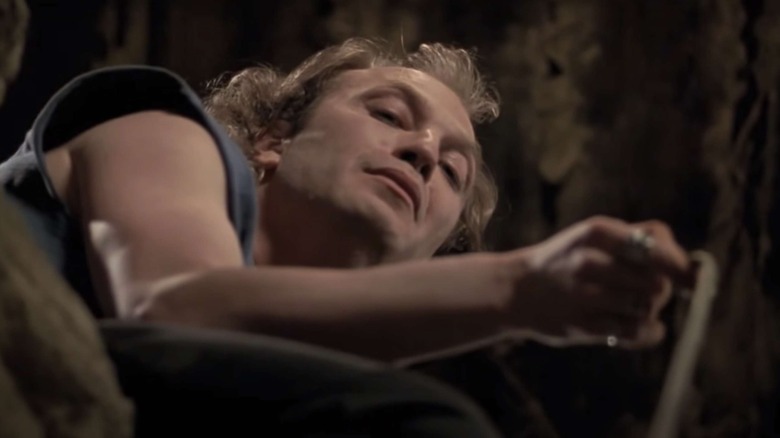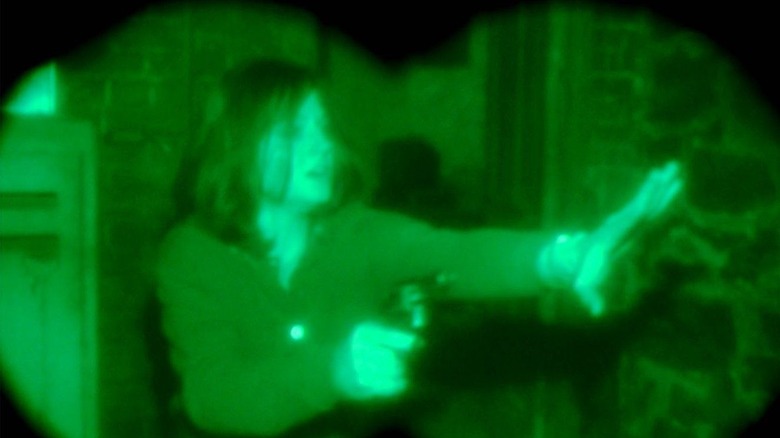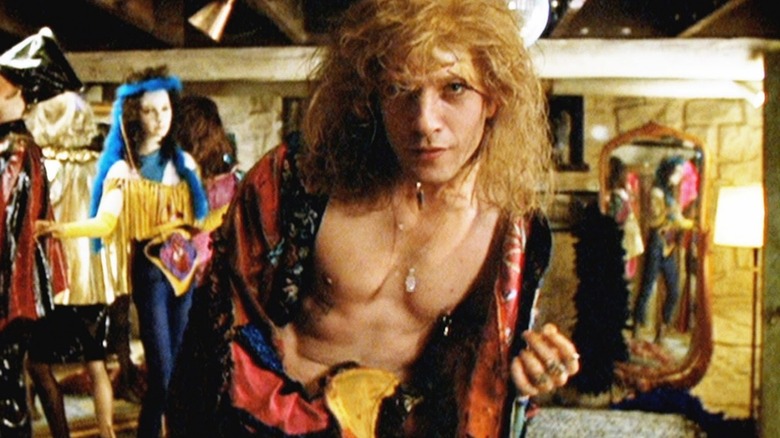The Buffalo Bill Scene In Silence Of The Lambs That Was Totally Improvised
At the 64th Academy Awards, it was all about "The Silence of the Lambs." The host, Billy Crystal, was wheeled onto the stage wearing Hannibal Lecter's famous muzzle, and by the end of the evening the film had swept the "Big Five" Oscars: Best Picture, Director, Actor, Actress, and Adapted Screenplay, becoming only the third film in the Academy's history to do so (after "It Happened One Night" and "One Flew Over the Cuckoo's Nest.")
It was a cannibal love-in, alright; in the building at least, because outside in the street several hundred protestors gathered to angrily decry the portrayal of gay characters in a number of the year's films, most notably "The Silence of the Lambs" for its transgender serial killer Buffalo Bill (via Advocate). Whether the film is transphobic or not remains a subject of debate today but that doesn't detract from the quality of Ted Levine's performance as Bill, which should have earned him an Oscar nomination too.
While Levine only has about ten minutes of screen time in the film, what he does with such a thinly written role is remarkable, every bit as impressive as Hopkins' lip-smacking Dr. Lecter. If anything, Levine's portrayal is more nuanced. Hopkins created one of the great screen villains, but there was a touch of theatricality about the performance that hinted at the caricature Lecter would become in "Hannibal." A few years later Dame Judi Dench won Best Supporting Actress for a five-minute walk-on in "Shakespeare in Love," so a nod to Levine's superb work certainly wouldn't have been outrageous.
On top of making Bill a character both frightening and pathetic, he also provided "The Silence of the Lambs" with one of its most memorable moments; the often-parodied "Goodbye Horses" dance that wasn't even in the script.
How the scene plays out
The FBI is on the trail of a serial killer nicknamed "Buffalo Bill," who, at the start of the film, has already claimed five victims, partially skinning their corpses and leaving a Death's Head Moth cocoon lodged in their throats. Senior agent Jack Crawford (Scott Glenn) pulls Clarice Starling (Jodie Foster) out of training for a special assignment. She must interview incarcerated Dr. Hannibal "The Cannibal" Lecter (Hopkins) to gain some psychological insight into Bill's horrific crimes.
Meanwhile, Bill, real name Jame Gumb (Levine), snatches his would-be sixth victim, Catherine Martin (Brooke Smith), the daughter of a U.S. Senator. He keeps her alive in a well in his basement, starving her to loosen up her skin so it'll be easier to remove once he murders her. We learn that Gumb was denied gender reassignment surgery and now he's tailoring himself a "woman suit" out of real women's skin to complete his transformation.
While Starling is playing psychological cat-and-mouse with Lecter, we see Gumb working diligently on his skin suit. Down below in the well, Catherine has hatched a plan to take his beloved dog, Precious, as a hostage to negotiate her way out of the hole.
Gumb is unaware that she is luring Precious with a leftover chicken bone because he's busy making himself up for a performance in front of his video camera. Draped in a shawl and wearing the scalp of a previous victim, he dances to "Goodbye Horses" by Q Lazzarus before an idea strikes him. Ducking out of the frame, he tucks his genitals between his legs to give himself the appearance of having a vagina. He stands back raising his arms in a wing-like pose, continuing the moth and butterfly symbolism throughout the movie.
Levine prepped hard for the role
For his research, Levine visited FBI headquarters in Quantico to view tapes of a serial killer who also kept women captive in his basement, enjoying the power he held over his victims before killing some of them. The actor also hung out in transvestite bars speaking to patrons and performers to get a handle on his character (via Rolling Stone).
The Jame Gumb character drew a lot of controversy from activists and continues to do so. Jonathan Demme defended his intentions, stating (via New York Times):
"He wasn't a gay character. He was a tormented man who hated himself and wished he was a woman because that would have made him as far away from himself as he could possibly be."
Perhaps because we spend so little time with Gumb, those motivations aren't clear. Screenwriter Ted Tally admitted that the character was a "cipher" compared to how Thomas Harris had written him and that Levine "rescued" him with his performance. Levine certainly uses every second he has on the screen to tell us something about Gumb's character. Just take the well scene where he calls Catherine "it." This seems to be a conscious decision to distance himself from the grisly truth of his actions because in the same scene he also refers to Catherine as "she" to his dog. He could be borrowing the Nazi's tactic of dehumanizing their victims; notably, Gumb has a bedspread embroidered with swastikas.
As Gumb demands Catherine send up the body lotion in a basket, he becomes tearful. Levine became good friends on set with Brooke Smith, and her improvised line "I want my mommy" provoked a real emotional response from him. The exchanges show that there is still some human feeling within Gumb before his psychosis takes over again and he mocks her screams.
A different interpretation from Jodie Foster
Jodie Foster had a different perspective on the "it" thing while talking about the climactic confrontation between Starling and Gumb (via Rolling Stone):
"He can't help but start to laugh because she's yet another 'it.' He can't help but laugh at women, because women are nothing. They're powerless and he's about to get her for her hair. She pulls a gun on him, and he keeps laughing because he thinks he's invincible. He can't possibly imagine that an 'it' could ever kill him because 'its' are like bugs you squash."
The scene never played that way to me. It's possible that Gumb saw Starling as an impromptu chance to harvest some more material for his suit, although he already has the hair and Starling's small frame doesn't match the body profile of his usual victims. She's definitely in danger, but he seems more interested in finding out from her how close he is to getting caught.
Then Starling notices the moth. I always took his smirk as a realization that the game is almost up, but he knows he still has a few surprises if he can make it back down to the basement. He takes a risk by running, but perhaps he has seen the fear in Starling's eyes and her shaking hands as she pulls her gun and figures she won't willingly shoot him in the back.
Once in his lair, Gumb's predatory instincts take over and he enjoys the power of stalking her with his night vision goggles. Far from feeling invincible, he needs the cover of darkness to tip the odds in his favor against an armed FBI agent. Fatally, however, he underestimates how quickly she will be prepared to fire once she hears him cock his gun.
Goodbye Horses
With little to work from in the screenplay, Demme and Levine worked out a lot of Gumb's character on set, including that infamous dance. Levine reasoned (via Rolling Stone):
"I think Gumb at one point thought that he might be a rock star in the mode of a David Bowie, those guys who were really masculine but feminine at the same time. Bowie influenced that, the Gumb mentality because he definitely fancied himself this powerful glitter rocker feminine thing but obviously wasn't."
The penis tuck moment was present in the novel but absent from the screenplay, but Levine made it integral to the scene. He needed a little dutch courage to perform the move, although he says that nudity wasn't a big deal for him since he'd gone it before on stage (via AV Club). The biggest bummer was shaving his body and doing "a little Brazilian" on himself, which apparently wasn't fun when it started growing back. Levine felt that Gumb pretending to have a vagina was essential to the character:
"It's something any boy can do at home. I really thought it would make it very accessible. It's something that I think most or a lot of boys who've got a little bit of imagination might have tried at some point or another."
Bob Seger's "Hot Strut" was the tune originally used while rehearsing the scene before "Goodbye Horses" took its place. Demme had already used the song to little effect in "Married to the Mob," but this time it suited the scene far better. With those nocturnal synths and spectral vocals, it has become synonymous with Buffalo Bill's most memorable moment, the perfect blend of music and startling imagery.
